
Mangifera is a genus of flowering plants in the cashew family, Anacardiaceae. It contains approximately 69 species, with the best-known being the Common Mango. The center of diversity of the genus is in the Malesian ecoregion of Southeast Asia; particularly in Sumatra, Borneo, and the Malay peninsula. They are generally canopy trees in lowland rainforests, reaching a height of 30–40 m (98–131 ft).
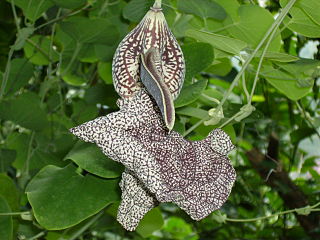
Aristolochia is a large plant genus with over 500 species that is the type genus of the family Aristolochiaceae. Its members are commonly known as birthwort, pipevine or Dutchman's pipe and are widespread and occur in the most diverse climates. Some species, like A. utriformis and A. westlandii, are threatened with extinction.

Avicennia is a genus of flowering plants currently placed in the bear's breeches family, Acanthaceae. It contains mangrove trees, which occur in the intertidal zones of estuarine areas and are characterized by its "pencil roots", which are aerial roots. They are also commonly known as api api, which in the Malay language means "fires", a reference to the fact that fireflies often congregate on these trees. Species of Avicennia occur worldwide south of the Tropic of Cancer.

Apeiba tibourbou is a tree native to Caatinga and Cerrado vegetation in Brazil, and Costa Rica. It is used as an alternative fiber crop to make paper. It is found in Mexico, Central America, and the northern part of South America.
Afrosison is a genus of 3 species of plants in the family Apiaceae, all of which are endemic to tropical Africa.
Agrocharis is a genus of 4 species of plants in the family Apiaceae, all of which are endemic to Africa, including Zimbabwe.
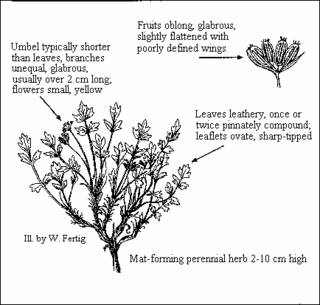
Aletes is a genus of about 15-20 species of plants in the family Apiaceae, all of which are endemic to North America.
Arcuatopterus is a genus of flowering plant in the Apiaceae, with 3 to 5 species. It is endemic to China.
Asteriscium is a genus of flowering plant in the family Apiaceae, with about 8 species. It is endemic to temperate South America.
Bonannia resinifera is a species of flowering plant in the Apiaceae, the only member of the genus Bonannia. It is endemic to southern Europe.

Bowlesia is a genus of flowering plant in the family Apiaceae, with over 15 accepted species.

Rodrigo Bernal González is a Colombian botanist who specialises in the palm family. Bernal was a faculty member at the Institute of Natural Sciences, National University of Colombia until 2007. He received his Ph.D. from the University of Aarhus, Denmark, in 1996. He was general curator of the National Colombian Herbarium (1986-1987), and editor of the scientific journal Caldasia.
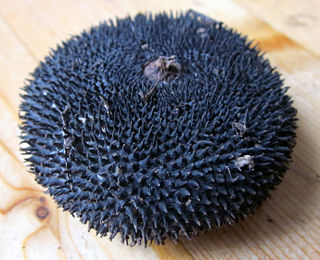
Apeiba is a genus of shrubs or trees in the family Malvaceae. It is native to tropical America.
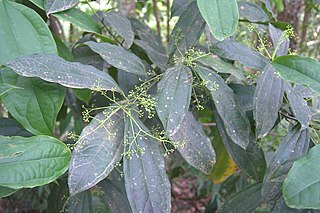
Aiouea is a genus of shrubs and trees in the family Lauraceae. It is native to tropical forests and montane forests of North and South America.
Gloria Amparo Galeano Garcés was a Colombian botanist and agronomist specializing in the palm family. Galeano was a faculty member at the National University of Colombia, and was the director of the Institute of Natural Sciences from 2003 to 2006. She received her Ph.D. from the University of Aarhus, Denmark in 1997.

Bruguiera is a plant genus in the family Rhizophoraceae. It is a small genus of five mangrove species and three hybrids of the Indian and west Pacific Ocean region, its range extending from East Africa and Madagascar through coastal India, Sri Lanka and Southeast Asia to northern Australia, Melanesia and Polynesia. It is characterised by calyces with 8-16 lanceolate, pointed lobes, 16-32 stamens, explosive release of pollen, and viviparous propagules. It is named in honour of French explorer and biologist Jean Guillaume Bruguière (1750–1798). Recently, the eighth taxa of Bruguiera, B. × dungarra was recognised as occurring in northern Australia.
Maquira is a genus of trees in the family Moraceae, native to South America.
Mayna is a genus of shrubs and trees in the family Achariaceae. It is native to the American tropics. It is dioecious, with male and female flowers produced on separate individuals.
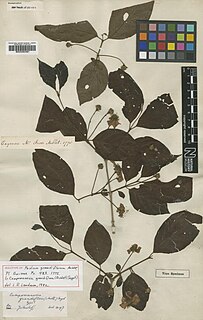
Campomanesia grandiflora is a species of tree the flowering plant family Myrtaceae. In Portuguese the species goes by the common name Acariquara branca.











